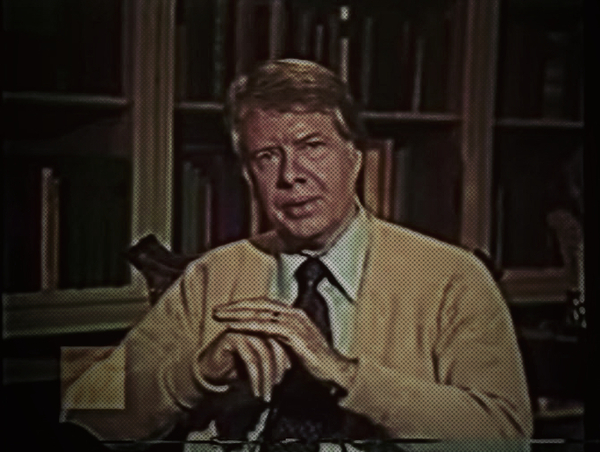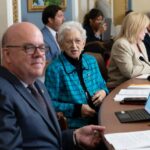
–>
August 16, 2022
The Biden administration’s climate policies have fueled double-digit inflation and negative growth in the nation’s Gross Domestic Product (GDP) not seen since 1979 when the OPEC oil embargo helped usher Ronald Reagan into the White House.
‘); googletag.cmd.push(function () { googletag.display(‘div-gpt-ad-1609268089992-0’); }); }
In the last year of his presidency, Jimmy Carter struggled because the OPEC oil embargo caused long lines at the gas pump to pay surging gasoline costs. In February 1977, during a nationally televised speech to the nation, Carter wore a cardigan sweater from a seat in the White House, urging Americans to turn down their thermostats to 65 degrees in the daytime and 55 degrees at night to waste less energy. Carter ushered in the Reagan presidency by arguing to Americans that the energy shortage was “permanent,” and urged a shift to “solar energy and other renewable energy sources.”
Also in 1979, to fight surging inflation, then-Fed Chair Paul Volker placed a lid on the money supply, raising interest rates, which peaked at 20.0% percent in June 1981. This dramatic move drove inflation down from a high of 14.8% in March 1980 to 2.5% three years later. The price of Volker’s decisive moves was that the U.S. economy suffered two punishing recessions.
The economic doom and gloom hanging over Carter’s presidency were perhaps best expressed in July 1979, in Carter’s infamous “malaise speech,” which he delivered from the White House exactly three years after accepting the Democrat Party nomination to run for president. “It’s clear that the true problems of our nation are much deeper—deeper than gasoline lines or energy shortages, deeper even than inflation or recession,” Carter said. “The erosion of our confidence in the future is threatening to destroy the social and political fabric of America.” Carter blamed the nation’s problems on America’s dependence on foreign oil during the 1970s, an era during which many believed the United States had run out of oil. “We believed that our nations resources were limitless until 1973, when we had to face a growing dependence on foreign oil.”

Image: Jimmy Carter (edited). YouTube screen grab.
‘); googletag.cmd.push(function () { googletag.display(‘div-gpt-ad-1609270365559-0’); }); }
In Biden’s case, the oil shortages and rising energy prices are self-inflicted wounds, not the result of foreign action, as with the OPEC oil embargo. As one of his first acts in office, Biden reversed a key Trump policy and canceled the Keystone Pipeline. This evidenced the Biden administration’s decision to move away from U.S. reliance on hydrocarbon fuels in favor of the Green New Deal’s push toward solar and wind power.
President Trump had proven the United States was nowhere near running out of oil. On August 20, 2019, the Energy Information Administration (EIA), the statistical agency of the U.S. Department of Energy, announced that the United States established new production records, with U.S. petroleum and natural gas production increasing in 2018 by 16% and 12%, respectively. The EIA further announced that the United States surpassed Russia in 2011 to become the world’s largest natural gas producer and surpassed Saudi Arabia in 2018 to become the world’s largest petroleum producer. The EIA report commented that the 2018 increase in the United States, which boomed under the Trump administration, constituted “one of the largest absolute petroleum and natural gas production increases from a single country in history.”
In sharp contrast, by mid-June, after five months in the White House, the Biden administration had to acknowledge that oil imports from Russia set a record high in March 2021. According to the International Energy Agency (IEA), U.S. imports of crude oil and petroleum products from Russia reached 22.9 million barrels in March 2021, despite strained relations between Washington and Moscow.
Under Biden, the United States is entering a period of stagflation last seen when Carter mused that running out of oil made renewable fuels America’s only alternative. In July 2022, the GDP dropped 0.9% in the second quarter of 2022, following a 1.6 percent decline in the first quarter. Once again, the U.S. is in a recession according to the principles of classic economics, which define the onset of a recession as two straight quarters of negative GDP growth.
“We’re not going to be in a recession,” President Joe Biden insisted last week. Yet, with persistent inflation edging into double-digit territory, the Fed can no longer insist that the end of the COVID lockdown caused only a “temporary” uptick in inflation that would not persist beyond the first months of 2022. On July 28, the Fed raised interest rates by another 75 basis points (0.75%) in the fourth interest rate hike this year, bringing the target interest range to 2.25% to 2.50%.
On July 13, the U.S. Bureau of Labor Statistics (BLS) reported that the Consumer Price Index (CPI) increased dramatically to 9.1% annually. The July surge in the CPI inflation rate was a 40-year high, making July the fifth time this year that the monthly CPI annual interest rate broke that mark. The BLS noted that the 11.2% increase in the June gasoline index was responsible for almost half of the rise in the June CPI, with increases in food and housing being the next most significant contributors to the dramatic rise of the CPI inflation index in June.
‘); googletag.cmd.push(function () { googletag.display(‘div-gpt-ad-1609268078422-0’); }); } if (publir_show_ads) { document.write(“
Then on July 14, the BLS reported that the Producer Price Index (PPI) rose to an 11.3% annual gain in June, the most significant calendar-year advance since November 2010, when the BLS first began calculating 12-month PPI data. The BLS again noted that June’s increases in the cost of gasoline and food were the two major contributors to June’s record PPI increase.
The Biden administration’s decision to implement the untested Modern Monetary Theory by injecting trillions of dollars in deficit spending made stagflation a near certainty given the administration’s ideological adherence to Green New Deal politics. Since shutting down the Keystone Pipeline, the Biden administration has made a series of decisions limiting the production of U.S. hydrocarbon fuels—fuels that the Trump administration proved were still abundant and relatively cheap reliable energy supplies.
Today, with gasoline averaging around $4/gallon in America, the Wall Street Journal reports that “an energy-starved world is turning to coal as natural gas and oil shortages exacerbated by Russia’s war against Ukraine lead countries back to the dirtiest fossil fuel.” Under pressure from Russian threats to close down the flow of natural gas to Europe, the European Parliament decided to include nuclear fuel and natural gas as “green energy” in its definition of environmentally sustainable economic activities.
Here in America, though, Congress passed the Biden administration’s “Inflation Reduction Act.” The legislation includes $368 billion for green energy spending intended to reduce CO2 emissions by 40%. This will almost certainly increase inflation by pumping even more deficit spending into the U.S. economy. In a repeat of “Solyndra Syndrome,” the failed renewable energy project the Obama administration financed with federal grants and tax breaks, the Biden administration is betting more potentially inflationary deficit spending against the odds that renewable energy will be profitable this time.
Meanwhile, the United Nations Intergovernmental Panel on Climate Change (IPCC) turns a blind eye to China, the world’s leading country in CO2 emissions. In 2020, China’s coal-intensive economy emitted more CO2 than America, the EU, and other developed nations combined. That year, China emitted 27% of all greenhouse gas emitted worldwide. Each year, China burns half of the coal burned worldwide. China is not about to let its 1.4 billion people freeze this winter. In America, however, many may have no choice but to suffer winter’s harshness amid the realities of increasingly costly energy in a mid-term year when Biden’s climate policies have pursued green energy initiatives at the cost of dramatically increased oil and natural gas prices with no limit in sight.
Since 2004, Jerome R. Corsi has published 25 books on economics, history, and politics, including two #1 New York Times bestsellers. In 1972, he received his Ph.D. from the Department of Government at Harvard University. He currently resides in New Jersey with his family. His current book, The Truth About Energy, Global Warming, and Climate Change: Exposing Climate Lies in an Age of Disinformation, published on June 28, 2022, was listed by Amazon.com as a “Best Seller” in the first week of sales. Dr. Corsi has launched a new website, DrJeromeCorsi.com, to support his many publications and continuing varied business interests.
<!– if(page_width_onload <= 479) { document.write("
“); googletag.cmd.push(function() { googletag.display(‘div-gpt-ad-1345489840937-4’); }); } –> If you experience technical problems, please write to [email protected]
FOLLOW US ON
<!–
–>
<!– _qoptions={ qacct:”p-9bKF-NgTuSFM6″ }; ![]() –> <!—-> <!– var addthis_share = { email_template: “new_template” } –>
–> <!—-> <!– var addthis_share = { email_template: “new_template” } –>





